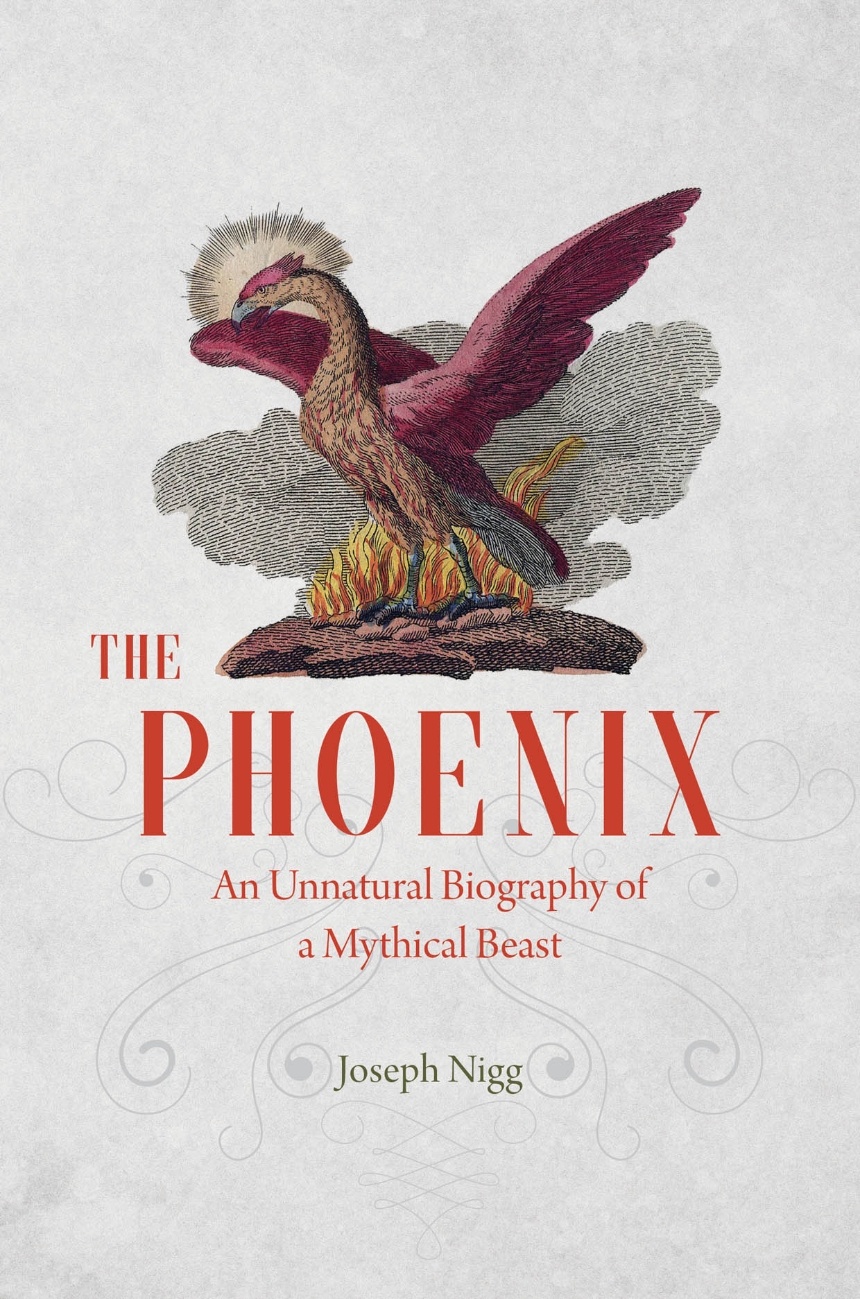The Phoenix
An Unnatural Biography of a Mythical Beast
Arising triumphantly from the ashes of its predecessor, the phoenix has been an enduring symbol of resilience and renewal for thousands of years. But how did this mythical bird become so famous that it has played a part in cultures around the world and throughout human history? How much of its story do we actually know? Here to offer a comprehensive biography and engaging (un)natural history of the phoenix is Joseph Nigg, esteemed expert on mythical creatures—from griffins and dragons to sea monsters.
Beginning in ancient Egypt and traveling around the globe and through the centuries, Nigg’s vast and sweeping narrative takes readers on a brilliant tour of the cross-cultural lore of this famous, yet little-known, immortal bird. Seeking both the similarities and the differences in the phoenix’s many myths and representations, Nigg describes its countless permutations over millennia, including legends of the Chinese “phoenix,” which was considered one of the sacred creatures that presided over China’s destiny; classical Greece and Rome, where it can be found in the writings of Herodotus and Ovid; nascent and medieval Christianity, in which it came to embody the resurrection; and in Europe during the Renaissance, when it was a popular emblem of royals. Nigg examines the various phoenix traditions, the beliefs and tales associated with them, their symbolic and metaphoric use, the skepticism and speculation they’ve raised, and their appearance in religion, bestiaries, and even contemporary popular culture, in which the ageless bird of renewal is employed as a mascot and logo, including for our own University of Chicago.
Never bested by hardship or defeated by death, the phoenix is the ultimate icon of hope and rebirth. And in The Phoenix: An Unnatural Biography of a Mythical Beast, it finally has its due—a complete chronicle worthy of such a fantastic and phantasmal creature. This entertaining and informative look at the
life and transformation of the phoenix will be the authoritative source for anyone fascinated by folklore and mythology, re-igniting our curiosity about one of myth’s greatest beasts.
Beginning in ancient Egypt and traveling around the globe and through the centuries, Nigg’s vast and sweeping narrative takes readers on a brilliant tour of the cross-cultural lore of this famous, yet little-known, immortal bird. Seeking both the similarities and the differences in the phoenix’s many myths and representations, Nigg describes its countless permutations over millennia, including legends of the Chinese “phoenix,” which was considered one of the sacred creatures that presided over China’s destiny; classical Greece and Rome, where it can be found in the writings of Herodotus and Ovid; nascent and medieval Christianity, in which it came to embody the resurrection; and in Europe during the Renaissance, when it was a popular emblem of royals. Nigg examines the various phoenix traditions, the beliefs and tales associated with them, their symbolic and metaphoric use, the skepticism and speculation they’ve raised, and their appearance in religion, bestiaries, and even contemporary popular culture, in which the ageless bird of renewal is employed as a mascot and logo, including for our own University of Chicago.
Never bested by hardship or defeated by death, the phoenix is the ultimate icon of hope and rebirth. And in The Phoenix: An Unnatural Biography of a Mythical Beast, it finally has its due—a complete chronicle worthy of such a fantastic and phantasmal creature. This entertaining and informative look at the
life and transformation of the phoenix will be the authoritative source for anyone fascinated by folklore and mythology, re-igniting our curiosity about one of myth’s greatest beasts.
Reviews
Table of Contents
Preface
Introduction: Cultural Transformations of the Phoenix
Prologue: Sacred to the Sun
Chapter 1 Egyptian Beginnings
Chapter 2 Royal Bird of China
Part I. Classical Marvel
Chapter 3 Birth of the Western Phoenix
Chapter 4 Early Roman Sightings
Chapter 5 Later Roman Variations
Part II. Bird of God
Chapter 6 The Judaic Phoenix
Chapter 7 The Early Christian Phoenix
Chapter 8 The Phoenix in Old English
Chapter 9 The Bestiary Phoenix
Chapter 10 Beyond the Bestiaries
Part III. Renaissance Transformations
Chapter 11 Innovations and Renewals
Chapter 12 The Elizabethan Phoenix
Chapter 13 The Emblematic Phoenix
Chapter 14 The Philosopher’s Stone
Chapter 15 Metaphorical Variety
Part IV. Challenged and Discredited
Chapter 16 Rising Doubts
Chapter 17 Battle of the Books
Chapter 18 Fading into Fable
Part V. Modern Rebirth
Chapter 19 Mythical Bird
Chapter 20 Poetic Fire
Chapter 21 Literary Distinction
Chapter 22 From Literal Ashes
Notes
Selected Bibliography
Acknowledgments
Index
Introduction: Cultural Transformations of the Phoenix
Prologue: Sacred to the Sun
Chapter 1 Egyptian Beginnings
Chapter 2 Royal Bird of China
Part I. Classical Marvel
Chapter 3 Birth of the Western Phoenix
Chapter 4 Early Roman Sightings
Chapter 5 Later Roman Variations
Part II. Bird of God
Chapter 6 The Judaic Phoenix
Chapter 7 The Early Christian Phoenix
Chapter 8 The Phoenix in Old English
Chapter 9 The Bestiary Phoenix
Chapter 10 Beyond the Bestiaries
Part III. Renaissance Transformations
Chapter 11 Innovations and Renewals
Chapter 12 The Elizabethan Phoenix
Chapter 13 The Emblematic Phoenix
Chapter 14 The Philosopher’s Stone
Chapter 15 Metaphorical Variety
Part IV. Challenged and Discredited
Chapter 16 Rising Doubts
Chapter 17 Battle of the Books
Chapter 18 Fading into Fable
Part V. Modern Rebirth
Chapter 19 Mythical Bird
Chapter 20 Poetic Fire
Chapter 21 Literary Distinction
Chapter 22 From Literal Ashes
Notes
Selected Bibliography
Acknowledgments
Index
